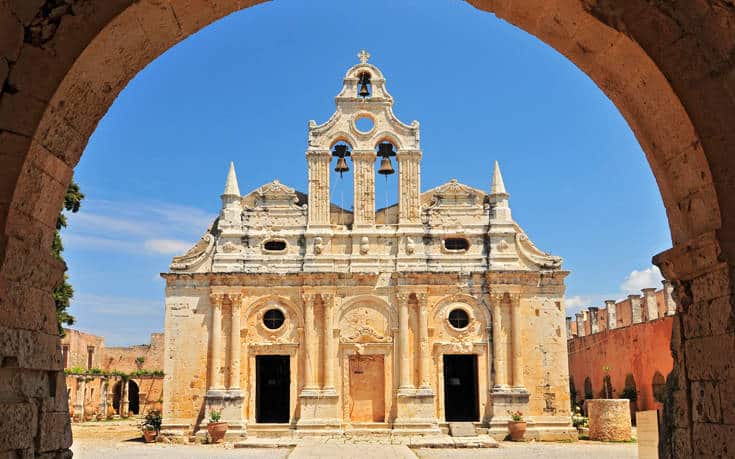
The Arkadi Monastery (Μονή Αρκαδίου) is one of Crete’s most venerated symbols of freedom.
By the mid-19th century, the Ottomans had occupied Crete for more than two centuries, despite frequent bloody uprisings by Cretan rebels determined to win independence and union with Greece.
During the Cretan revolt of 1866, the Arkadi monastery played an active role in the Cretan resistance of Ottoman rule. It was manned by 259 armed men (including 45 monks) and sheltered 943 Greeks (mostly women and children) seeking refugee from the encroaching Turks.
On the morning of 8 November, an army of 15,000 Ottomans and 30 cannons, directed by Turkish commander Suleyman, arrived on the hills of the monastery. Suleyman sent a last request for surrender, however the Cretans responded with gun fire.
The battle stopped with nightfall, and began again in the evening of November 9. Cannons destroyed the doors of the monastery and the Turks made it into the building. At the same time, the Cretans were running out of ammunition and they were forced to battle with only bayonets or other sharp objects. The Turks had the advantage.
The last Cretan fighters were finally defeated and hid within the monastery. Thirty-six insurgents found refuge in the refectory, near the ammunitions. Discovered by the Ottomans, who forced the door, they were massacred.

Meanwhile, the women and children were hiding in the monastery’s storage room. The Turkish soldiers had them surrounded. That is when Cretan patriot Konstantinos Giaboudakis gathered the consensus of all inside to do the unthinkable- set the barrels of powder on fire and die, choosing to sacrifice themselves rather than surrender. The explosion also killed more than 1,500 Ottoman soldiers.
Of the 964 people present at the start of the assault, 846 were killed in combat or at the moment of the explosion. 114 men and women were captured, but three or four managed to escape, including one of the messengers who had gone for reinforcements. The remains of numerous Cretan Christians were collected and placed in the windmill, which was made into a reliquary in homage to the defenders of Arkadi.

The Ottomans considered taking Arkadi a big victory and celebrated it with cannon fire. However, the tragedy of Arkadi turned world opinion on the conflict. Volunteers from Serbia, Hungary and Italy arrived on the island.
Frenchman Gustave Glourens, a teacher at the Collège de France, enlisted and arrived in Crete by the end of 1866. He formed a small group of philhellenists with three other Frenchmen, an Englishman, an American, an Italian and a Hungarian. This group published a brochure on ‘The question of the Orient and the Cretan Renaissance’, contacted French politicians and organised conferences in France and in Athens.
Italian general Giuseppe Garibaldi wrote letters praising the patriotism of the Cretans and their wish for independence.
Letters written by French poet Victor Hugo were published in the newspaper ‘Kleio’ in Trieste, which contributed to the worldwide reaction. The letters gave encouragement to the Cretans and told them that their cause would succeed. He described the tragedy of Arkadi:
“One knows this word, Arkadi, but one hardly understands what it means. And here are some of the precise details that have been neglected. In Arkadi, the monastery on Mount Ida, founded by Heraclius, six thousand Turks attacked one hundred ninety-seven men and three hundred forty-three women and also children. The Turks had twenty-six cannons and two howitzers, the Greeks had two hundred forty rifles. The battle lasted two days and two nights; the convent had twelve hundred holes found in it from cannon fire; one wall crumbled, the Turks entered, the Greeks continued the fight, one hundred fifty rifles were down and out and yet the struggle continued for another six hours in the cells and the stairways, and at the end there were two thousand corpses in the courtyard. Finally the last resistance was broken through; the masses of the Turks took the convent. There only remained one barricaded room that held the powder and, in this room, next to the altar, at the center of a group of children and mothers, a man of eighty years, a priest, the hegumen Gabriel, in prayer… the door, battered by axes, gave and fell. The old man put a candle on the altar, took a look at the children and the women and lit the powder and spared them. A terrible intervention, the explosion, rescued the defeated…and this heroic monastery, that had been defended like a fortress, ended like a volcano.”
Not finding the necessary solution from the big European powers, the Cretans sought aid from the United States. The Americans became sympathetic toward the Cretans’ efforts and many American philhellenes arrived to advocate for the idea of Cretan independence.
In 1868 a question of whether to recognise Cretan independence was addressed in the House of Representatives, but the majority ultimately voted not to intervene in Ottoman affairs.
In 1898, with help from Greece and the Great Powers (England, France, Italy and Russia), Crete won its independence and the Turks withdrew from the island, which they had held since 1669.
Then in 1913, the long-fought-for goal was achieved and Crete was united with Greece.
The Arkadi Monastery became a national sanctuary in honour of the Cretan resistance. 8 November is a day of commemoration. The explosion did not end the Cretan insurrection, but it attracted the attention of the rest of the world.
See also
The feast of the Angels & St. Nektarios the Wonderworker in the Orthodox Church (8 + 9 November)

Δεν υπάρχουν σχόλια:
Δημοσίευση σχολίου